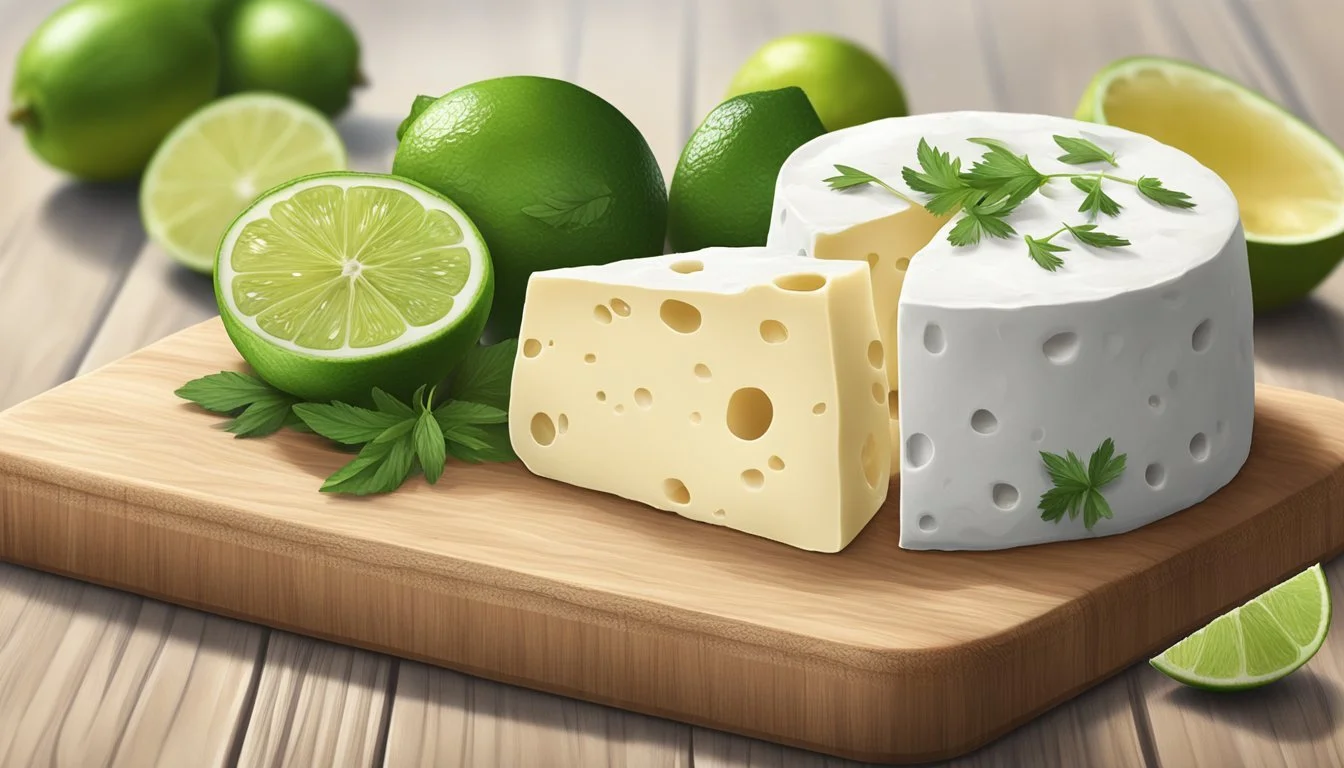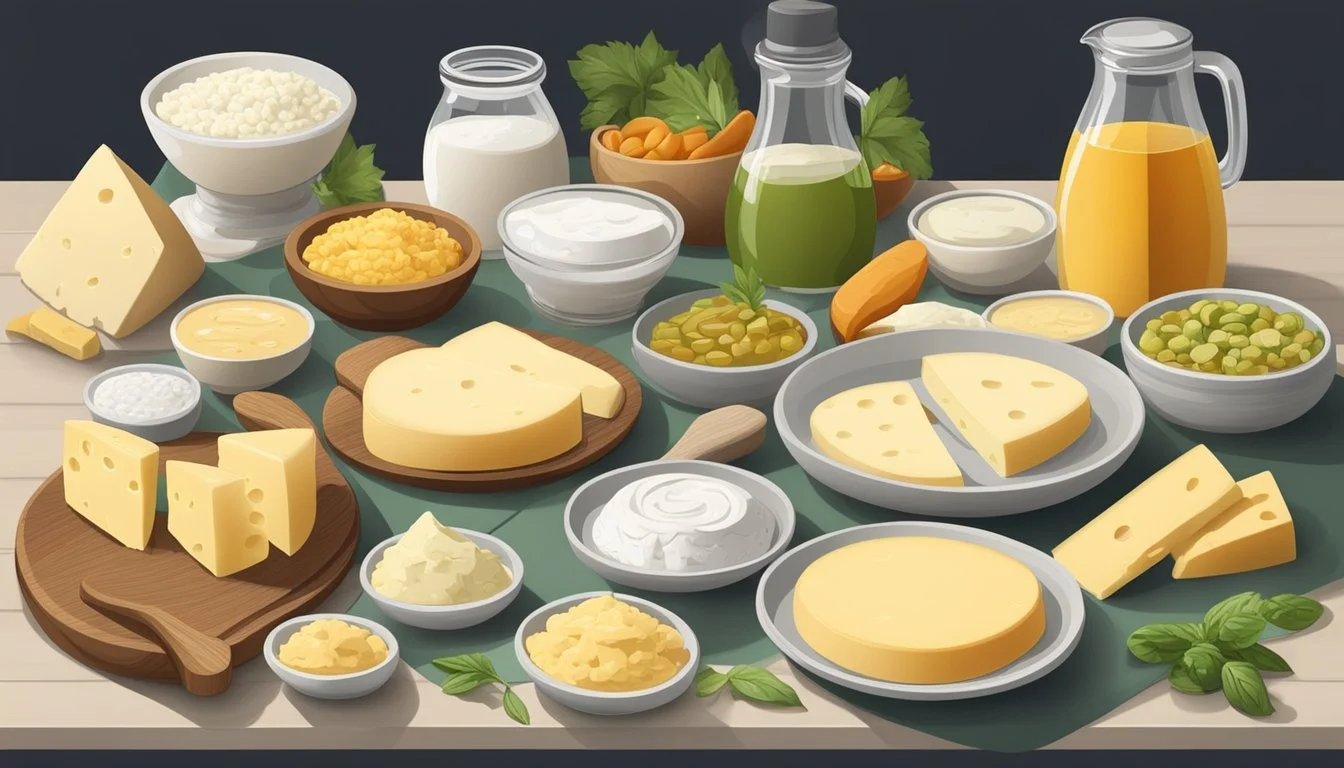Queso Blanco, Queso Fresco Substitutes
Top Alternate Cheeses for Your Recipes
Queso Blanco and Queso Fresco are staple Mexican cheeses renowned for their versatility in culinary applications, yet there are times when they may be unavailable or someone might be seeking an alternative with a different flavor or texture profile. Queso Blanco, often known for its mild taste and ability to retain shape when heated, is used in numerous traditional and contemporary dishes. Its slightly creamy and crumbly cousin, Queso Fresco, is celebrated for the fresh and mild flavor it adds to a plate.
When these cheeses are not at hand, or a recipe calls for something a bit different, various substitutes can be employed without compromising the integrity of the dishes. Paneer, an Indian cheese, stands out as an excellent substitute for Queso Fresco due to its similar soft but firm texture and mild, milky flavor. For Queso Blanco, one may lean towards Farmer's Cheese, which, like Queso Blanco, does not melt and can be a perfect addition to maintain the texture of a dish.
Having a repertoire of substitutes not only rescues a recipe when a specific cheese is missing from the pantry but also allows for experimenting with new flavors and textures that could enhance a dish. Feta cheese, for example, brings a salty tang and similar crumbling characteristic that could be ideal for certain dishes traditionally topped with Queso Fresco, while goat cheese might offer a sophisticated twist to a meal typically made with Queso Blanco. Each option brings its unique attributes and can serve as a viable stand-in for various Mexican cheeses, ensuring no recipe goes untried due to a lack of specific ingredients.
Understanding Queso Blanco and Queso Fresco
Queso Blanco and Queso Fresco are quintessential cheeses in Mexican cuisine, with distinct textures and flavors that contribute to their wide use in various dishes. These fresh cheeses are staples in Latin American culinary traditions, providing a creamy and milky quality to an array of recipes.
Origins and Popularity
Queso Blanco, or "White Cheese," is a type of soft, crumbly cheese that originated in Latin America. Its name derives from its white color and it holds a significant place in Mexican and other Latin American cuisines. Queso Fresco, which means "Fresh Cheese," is also a Mexican cheese known for its fresh, milky quality. Both cheeses are traditionally made from cow's milk, although Queso Fresco can sometimes include goat milk as well.
Texture and Flavor Profile
The texture of Queso Blanco is semi-soft and crumbly, which makes it suitable for grilling or frying as it is heat-resistant. It tends to have a slightly acidic and tangy bite. In contrast, Queso Fresco is often softer and moister, with a mild flavor and a creamy mouthfeel, but it also possesses a crumbly texture that can vary in firmness.
Cheese Type Texture Flavor Queso Blanco Semi-soft, crumbly Acidic, tangy Queso Fresco Soft, moist, crumbly Mild, creamy
Incorporated into Mexican dishes, these cheeses add a creamy, milky touch that balances out the robust flavors of the cuisine. The mild taste of Queso Fresco makes it versatile, often used as a topping or stuffing, while Queso Blanco's firmness allows it to hold shape when cooked.
Common Uses for Queso Blanco and Queso Fresco
Queso Blanco and Queso Fresco are staples in Mexican cuisine, favored for their unique textures and mild flavors. They are integral to many traditional dishes and offer culinary versatility, whether melted, crumbled, or used as a garnish.
In Traditional Mexican Dishes
In Mexican cuisine, Queso Fresco is often crumbled over tacos, enchiladas, and quesadillas. Its soft, moist texture and mild, slightly acidic tang complement the robust flavors of Mexican dishes. Queso Blanco, on the other hand, holds up well to heat; it can be fried or grilled, making it a perfect topping for empanadas or an authentic cheese crisp that can be diced into salads or soups.
Queso Fresco serves as a fresh contrast in texture and flavor when added to soups and salads. This cheese does not melt easily, therefore, it's excellent for maintaining structure in hot dishes while providing a refreshing creaminess.
Culinary Versatility
Both cheeses are celebrated for their versatile nature in the kitchen.
Queso Blanco:
Melting: Ideal for a smooth, gooey consistency in sauces or Mexican dishes
Dicing: Adds a savory edge to salads as a hearty, protein-rich ingredient
Frying: Perfect for creating a lightly browned, heat-stable element in various recipes
Queso Fresco:
Crumbling: Offers a delicate, bright topping for almost any dish, enhancing flavor without overpowering
Garnish: Serves as an eye-catching, flavorful addition to both hot and cold dishes, including tacos and salads
Balancing*: Its mild taste makes it a complementary sidekick to bold and spicy ingredients within Mexican cuisine
These cheeses are easy to incorporate into a wide array of culinary creations, making them a go-to choice for both traditional and innovative fare.
Cheese Substitutes for Queso Blanco and Queso Fresco
When seeking alternatives for Queso Blanco and Queso Fresco, it is important to consider both the texture and meltability of the substitutes, as well as their flavor profiles. The following sections outline suitable substitutes that closely match the characteristics of these traditional Mexican cheeses, catering to various culinary needs.
Substitutes Based on Texture and Meltability
Feta: A crumbly and slightly grainy texture makes feta a good stand-in, especially when a recipe requires a cheese that doesn’t need to melt.
Paneer: With similar characteristics to Queso Fresco, paneer has a firm but soft texture that holds up well when fried or added to heated dishes.
Monterey Jack: This cheese melts smoothly, making it ideal for dishes that require a melty consistency akin to Queso Blanco.
Farmer’s Cheese: Known for its crumbly texture, farmer’s cheese can be used in similar applications as Queso Fresco when melting is not a key factor.
Cottage Cheese: Although slightly juicier, its lumpy texture works in dips and salads, but may require straining for recipes that need a firmer cheese.
Substitutes Based on Flavor Similarity
Feta: While it is tangy and salty, feta’s mild version resembles the flavor profile of Queso Fresco when a salty tang is desired.
Ricotta: Offers a smooth, mild flavor that echoes the mildness of Queso Blanco, suitable for lasagna and pasta fillings.
Cotija: With its salty and savory punch, cotija can bring the depth of flavor needed to replace Queso Fresco in many dishes.
Monterey Jack: Its mild flavor and subtle sweetness can replicate the understated flavor profile of Queso Blanco in various recipes.
Non-Dairy and Vegan Substitutes
Tofu: A firm tofu, when crumbled, mimics the texture of Queso Fresco and can be seasoned to enhance flavor, serving as a dairy-free option.
Vegan Cheeses: Various plant-based cheese alternatives exist that are designed to mirror the meltability and flavor of traditional cheeses for fully vegan applications.
By considering these alternatives, it is possible to select an appropriate substitute for Queso Blanco and Queso Fresco that suits any recipe, accommodating dietary preferences and ensuring successful culinary ventures.
Specific Cheese Alternatives to Queso Blanco and Queso Fresco
For those seeking alternatives to Queso Blanco and Queso Fresco, a variety of cheeses offer similar qualities such as a mild taste, crumbly texture, and versatility in recipes.
Mild and Milky Cheese Substitutes
Paneer: A non-melting Indian cheese that offers a sweet, mild flavor and soft yet firm texture, making it a suitable substitute in many dishes.
Monterey Jack Cheese: Known for its delicate, buttery flavor and mild taste, it provides a melty quality similar to Mozzarella, ideal for a creamy sensation.
Crumbling Cheese Options
Feta Cheese: This Greek cheese is known for its crumbly texture and salty tang. Use in equal amounts as Queso Fresco for a slightly tangier taste.
Cotija Cheese: A Mexican cheese that is saltier and can provide a dry, crumbly texture akin to aged Queso Fresco in salads and on top of tacos.
Rich and Creamy Cheese Varieties
Ricotta Cheese: Ricotta offers a creamy, slightly sweet profile, suitable for dips and spreads where a milder yet rich cheese is required.
Goat Cheese: While tangier, goat cheese provides a creamy consistency and can replicate the softness of Queso Fresco in many recipes.
Firm Cheese Alternatives
Halloumi Cheese: With a robust texture that stands up to grilling, Halloumi can be a good alternative when a firm cheese is needed.
Extra Firm Tofu: Although not a cheese, for those who prefer a vegan option, extra firm tofu can mimic the firmness and can absorb flavors well in a variety of dishes.
Non-Cheese Substitutes
When considering cheese alternatives for Queso Blanco and Queso Fresco, one innovative route is plant-based. These substitutes often leverage key ingredients like acids and plant proteins to replicate the texture and tangy flavor associated with traditional cheeses.
Plant-Based and Tofu Variants
For those seeking a vegan alternative to Queso Blanco or Queso Fresco, tofu stands out as a top choice. Its texture and protein content make it an excellent cheese substitute, with the firmness being adaptable based on preparation method. Using acids like lemon juice or vinegar can lend the tangy taste commonly desired in cheese.
Lemon Juice: Adds a fresh, citrus tang to tofu, mimicking the acidic profile of queso.
Vinegar: Provides a sharper, more pronounced acid kick which can be tempered to suit individual preferences.
By pressing and crumbling tofu, and then marinating it with the selected acid, one creates a cheese-like consistency and flavor. Draining the whey from blended tofu can further refine the texture, moving it closer to that of queso's crumbliness.
Whether for ethical reasons or dietary restrictions, tofu and plant-based vegan alternatives offer a versatile and accessible option for those looking to replicate the experience of traditional Queso Blanco and Queso Fresco without the use of dairy.
Preparation Tips for Using Substitutes
When substituting for Queso Blanco or Queso Fresco, one should be mindful of the differences in cooking times, flavor profiles, texture compatibility, and nutritional content to successfully incorporate alternatives into dishes.
Cooking and Prep Time Adjustments
Texture: Substitutes like ricotta cheese may have a smoother texture and can result in shorter prep times as they do not require pressing and draining as with Homemade Queso Fresco. When using a substitute such as goat cheese, its semi-soft texture can also alter the total cooking time.
Total Time: If substitutes are pre-made, this can significantly reduce preparation and cook time. Ensure to readjust the timing within recipes where the melting or integration of the cheese is necessary to avoid overcooking.
Customizing Flavor and Texture
Savory Dishes: To mirror Queso Blanco's mild flavor, one can season substitutes with Spices and Herbs. Adding a pinch of salt or a squeeze of lemon can enhance the cheese's presence in savory dishes.
Sweet Dishes: For dishes requiring a delicate sweetness, such as desserts, Ricotta Cheese can replace Queso Fresco, as it has a subtle sweetness which suits pastries and fillings.
Nutritional Considerations
Lactose Intolerant: Those with lactose sensitivity should consider using substitutes that are lower in lactose. Aged cheeses are often more tolerable.
Nutrition: Substitutes vary in Calcium and Vitamin B12 content. For a similar nutritional profile, select cheeses that align closely with Queso Blanco, which is traditionally high in these nutrients.
Making Homemade Queso Fresco
Crafting Queso Fresco at home is a straightforward process requiring only a few basic ingredients and kitchen tools. This fresh cheese delivers a mild yet distinctive flavor, ideal for complementing a variety of dishes.
Basic Ingredients and Equipment
One begins with milk—preferably whole milk for its richness—acting as the foundational component of Homemade Queso Fresco. The cheese’s texture is achieved by adding an acid, typically vinegar or lemon juice, which curdles the milk. Alternatively, rennet can be used as a coagulating agent, as it is traditional in cheese-making. To fashion the cheese, one will need a pot to heat the milk, a colander to separate the curds from the whey, and cheesecloth to aid in the straining and shaping process.
Ingredients Quantity Equipment Needed Whole Milk 1 gallon Large Pot White Vinegar or Lemon Juice 1/4 cup Colander Salt (optional) 1-2 teaspoons Cheesecloth
Step-by-Step Instructions
One initiates the process by gently heating the milk in the large pot until it reaches a temperature just below boiling, around 185ºF to 195ºF. Vigilance is key; the milk should not be allowed to boil. Once the appropriate temperature is reached, the heat is turned off, and the acid—either vinegar or lemon juice—is uniformly stirred into the milk. This will cause the milk to curdle, creating the curds necessary for Queso Fresco.
Then, the pot is set aside for about an hour, allowing the curds and whey to separate. Subsequently, the mixture is poured into a colander lined with cheesecloth that resides over a bowl to catch the whey. If preferred, salt can be sprinkled into the curds at this stage to enhance flavor.
The curds are gathered within the cheesecloth, squeezed to expel excess whey, and then shaped into a desired form. Pressure is applied to compact the curds further. The cloth-wrapped cheese is then refrigerated and left to set, usually for a few hours, solidifying into its final, crumbly texture. After setting, the Homemade Queso Fresco is ready to be enjoyed as a versatile component in various culinary endeavors.
Cultural Significance and Final Thoughts
In the culinary tapestry of Latin America, particularly within Mexican cuisine, Queso Fresco plays a pivotal role. This soft, crumbly cheese is often sprinkled on tacos, enchiladas, and other traditional dishes, imparting a mild yet distinct flavor that is cherished in the region. Its presence in recipes is not merely a matter of taste but also of cultural heritage, as it reflects centuries-old cheese-making traditions.
While Queso Fresco is a staple in Latin American kitchens, Queso Blanco, which translates to 'white cheese', similarly claims its place in various culinary practices. Both cheeses are appreciated for their versatility and the gentle flavor they lend to a myriad of dishes.
Outside of Latin America, finding authentic Queso Fresco can be a challenge. However, one can turn to a global palette of cheese to find suitable alternatives:
India offers Paneer, a fresh cheese known for its sweet, milky taste and firm texture, acting as an adept stand-in.
In Greece, Feta is often recommended, with its crumbly yet creamy consistency and tangier profile, adapting well in salads and baked dishes.
Substitute Origin Texture Flavor Best Used In Paneer India Firm, Crumbly Sweet, Milky Stir-fries, Curries Feta Greece Crumbly, Creamy Briny, Tangy Salads, Pies
These cheeses enrich their respective cuisines while lending themselves as adaptable options for those seeking the essence of Queso Fresco beyond its geographical bounds. They demonstrate the beauty of cultural exchange in gastronomy, allowing flavors from one corner of the world to complement and enhance the dishes of another.





